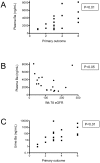Complement Activation in Patients with Focal Segmental Glomerulosclerosis
- PMID: 26335102
- PMCID: PMC4559462
- DOI: 10.1371/journal.pone.0136558
Complement Activation in Patients with Focal Segmental Glomerulosclerosis
Abstract
Background: Recent pre-clinical studies have shown that complement activation contributes to glomerular and tubular injury in experimental FSGS. Although complement proteins are detected in the glomeruli of some patients with FSGS, it is not known whether this is due to complement activation or whether the proteins are simply trapped in sclerotic glomeruli. We measured complement activation fragments in the plasma and urine of patients with primary FSGS to determine whether complement activation is part of the disease process.
Study design: Plasma and urine samples from patients with biopsy-proven FSGS who participated in the FSGS Clinical Trial were analyzed.
Setting and participants: We identified 19 patients for whom samples were available from weeks 0, 26, 52 and 78. The results for these FSGS patients were compared to results in samples from 10 healthy controls, 10 patients with chronic kidney disease (CKD), 20 patients with vasculitis, and 23 patients with lupus nephritis.
Outcomes: Longitudinal control of proteinuria and estimated glomerular filtration rate (eGFR).
Measurements: Levels of the complement fragments Ba, Bb, C4a, and sC5b-9 in plasma and urine.
Results: Plasma and urine Ba, C4a, sC5b-9 were significantly higher in FSGS patients at the time of diagnosis than in the control groups. Plasma Ba levels inversely correlated with the eGFR at the time of diagnosis and at the end of the study. Plasma and urine Ba levels at the end of the study positively correlated with the level of proteinuria, the primary outcome of the study.
Limitations: Limited number of patients with samples from all time-points.
Conclusions: The complement system is activated in patients with primary FSGS, and elevated levels of plasma Ba correlate with more severe disease. Measurement of complement fragments may identify a subset of patients in whom the complement system is activated. Further investigations are needed to confirm our findings and to determine the prognostic significance of complement activation in patients with FSGS.
Conflict of interest statement
Figures




References
-
- Gephardt GN, Tubbs RR, Popowniak KL, McMahon JT. Focal and segmental glomerulosclerosis. Immunohistologic study of 20 renal biopsy specimens. Arch Pathol Lab Med. 1986;110:902–905. - PubMed
Publication types
MeSH terms
Substances
Grants and funding
LinkOut - more resources
Full Text Sources
Other Literature Sources
Research Materials
Miscellaneous

